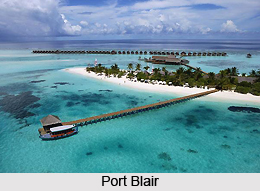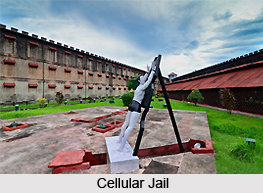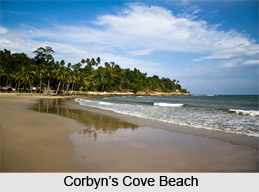 Port Blair, situated in the South Andaman district of the Andaman Islands, is a municipal council, headquarters and the largest city of the district. It also serves as the capital of the Andaman and Nicobar Islands which is a union territory of India. Being located at the east coast of South Andaman Island, it forms the main point of entry to the island. It is also the local administrative sub-division or tehsil of South Andaman district. Port Blair also serves as the headquarters of the first integrated theatre command of the armed forces, called the Andaman and Nicobar Command. The place houses a number of museums. In addition to being a major naval base of the Indian Navy called INS Jarawa it also forms the air and sea bases of the Indian Air Force and the Indian Coast Guard. Port Blair also hosts the historic Cellular Jail and several other small islands which were once inhabited by the British colonists. Main languages spoken in Port Blair include Bengali, Tamil, Hindi, Malayalam, Nicobarese, English, Punjabi and Telugu.
Port Blair, situated in the South Andaman district of the Andaman Islands, is a municipal council, headquarters and the largest city of the district. It also serves as the capital of the Andaman and Nicobar Islands which is a union territory of India. Being located at the east coast of South Andaman Island, it forms the main point of entry to the island. It is also the local administrative sub-division or tehsil of South Andaman district. Port Blair also serves as the headquarters of the first integrated theatre command of the armed forces, called the Andaman and Nicobar Command. The place houses a number of museums. In addition to being a major naval base of the Indian Navy called INS Jarawa it also forms the air and sea bases of the Indian Air Force and the Indian Coast Guard. Port Blair also hosts the historic Cellular Jail and several other small islands which were once inhabited by the British colonists. Main languages spoken in Port Blair include Bengali, Tamil, Hindi, Malayalam, Nicobarese, English, Punjabi and Telugu.
History of Port Blair
Port Blair history dates back to 2200 years. Port Blair was earlier inhabited by the tribes of the islands. These tribes were scattered throughout the islands until British captured the island and made it one of their administrative centres.
Early history: The early history of Port Blair is closely intertwined with the presence of its indigenous inhabitants known as the Andamanese people, consisting of several indigenous tribes. Investigations have shed light on this historical narrative, primarily through radiocarbon dating studies conducted on kitchen refuse dumps discovered within the mounds excavated by the Anthropological Survey of India in the vicinity of Choladari, near Port Blair.
The findings of these studies reveal a substantial human presence in the region dating back at least 2,000 years. Moreover, it is noteworthy that the Andamanese population likely diverged from the inhabitants of the mainland even before this extended period of occupation. The archaeological evidence recovered from the excavations underscores the enduring connection of the Andamanese people to the lands they have inhabited for millennia.
Modern History: History of Port Blair dates back to the year 1789 when a penal colony was established by the Bengal Government on Chatham Island situated in the southeast bay of Great Andaman as a tribute to Lieutenant Archibald Blair of the Company. In the honour of the officer it was named as Port Blair. The colony however moved to the north-eastern region of Great Andaman after two years and was named as Port Cornwallis to honour Admiral William Cornwallis. Its further operation by the government was ceased owing to diseases and death in the colony. Later the Indian Rebellion of 1857 rendered a number of prisoners to the British for which a necessity for establishing a settlement and prison in the island emerged. In the renovated Port Blair, the constructions began in 1857. The convicts imprisoned here mostly comprised political prisoners who were subjected to cruel punishments. Between 1896 and 1906 the massive Cellular Jail, also called Kala Pani, was constructed here as a consequence of the growing Indian freedom movement. During World War II, Port Blair became the headquarters of the Azad Hind Fauj under the commandership of Subhas Chandra Bose.
Geography of Port Blair
Port Blair enjoys a tropical monsoon climate. The average temperature variation in the city is minimum and it receives heavy precipitation all round the year. Except in the months of January, February and March, Port Blair receives considerable rainfall. The temperature in summers is between 28 to 30 degree Celsius and during winters it varies from 22 to 23 degree Celsius.
Demography of Port Blair
According to the 2011 India census the population of Port Blair is 100,608 with 52.92 percent (53,247) males and 47.07 percent (47,361) females. The average literacy of the city is 89.76 percent which is higher than the national average, 72 percent. Female literacy rate is 86.34 percent while the male literacy is 92.79 percent. The population which is under the age of 6 years constitutes 9.3 percent.
Administration in Port Blair
The Port Blair Municipal Council (PBMC), an abbreviated form of its full name, serves as the governing civic entity overseeing the administration of Port Blair. Port Blair stands as both the capital and the largest city within the Indian union territory known as the Andaman and Nicobar Islands. This authoritative council`s inception dates back to the 2nd of October in the year 1957, following the President of India`s approval of the Andaman & Nicobar Islands (Municipal Board"s) Regulation, 1957 Act on the 11th of March that same year.
The composition of the council encompasses a total of 24 designated wards, a configuration established through recent delimitation efforts and the expansion of the city`s boundaries. This expansion involved the amalgamation of several adjoining villages, complementing the pre-existing 18 wards.
Tourism in Port Blair
The captivating cluster islands of Port Blair, a prominent destination within the Andaman archipelago, offer a plethora of exploration opportunities for tourists. With its crystal-clear cerulean waters, verdant trekking trails bordered by lush green and earthy brown thickets, and rich cultural history intertwined with India, Port Blair stands as an alluring destination for travelers. Tourism department of the union territory has named the city as `the veritable garden of Eden`. Port Blair offers a number of wondrous experiences to the tourists.
 Cellular Jail: This historical site stands as a poignant reminder of India`s struggle for independence. Once a colonial prison, it now serves as a symbol of sacrifice and resilience.
Cellular Jail: This historical site stands as a poignant reminder of India`s struggle for independence. Once a colonial prison, it now serves as a symbol of sacrifice and resilience.
Chatham Saw Mill: An essential visit for history enthusiasts, this mill holds significance for its Japanese bunkers, museum, and a bomb pit that bears witness to the turbulent World War II era.
Manglutan Village and the Rubber Plantations: Get mesmerized in the scenic beauty of rubber plantations in Manglutan Village, a unique experience that offers insight into the local economy and culture.
Rajiv Gandhi Water Sports Complex: Embark on thrilling water-based activities at this complex, allowing visitors to engage in various sports and leisurely pursuits.
Madhuban Ranges: Perfect for nature lovers, this location provides a bird`s eye view of the picturesque landscapes, offering an immersive experience amidst nature`s beauty.
 Corbyn"s Cove Beach: A tranquil destination for beach enthusiasts, Corbyn"s Cove offers a serene atmosphere for relaxation and water-based activities.
Corbyn"s Cove Beach: A tranquil destination for beach enthusiasts, Corbyn"s Cove offers a serene atmosphere for relaxation and water-based activities.
Chidiya Tapu: Known as the "Bird Island," Chidiya Tapu is a haven for birdwatchers and nature admirers, offering a diverse range of avian species to observe.
Ferar Beach: A secluded and serene beach that provides an ideal spot for solitude seekers and those yearning for a peaceful escape.
Lamiya Bay Beach: Revel in the unspoiled beauty of Lamiya Bay, where pristine sands and clear waters create a soothing ambiance.
Aamkunj Beach: A lesser-explored gem, Aamkunj Beach offers a secluded retreat, perfect for leisurely strolls and unwinding by the shoreline.
Karmatang Beach: Known for its tranquility and striking natural beauty, Karmatang Beach beckons visitors to bask in the splendor of its shores.
Diglipur Island: A haven of biodiversity, this island features a mix of terrestrial and marine ecosystems, making it a must-visit for nature enthusiasts.
Samudrika Marine Museum: Immerse yourself in the marine heritage of the Andaman Islands through this museum`s diverse exhibits, ranging from marine life to geographical insights.
Anthropological Museum: Gain insights into the indigenous cultures and history of the islands through a comprehensive collection of artifacts and displays.
Adventure sports like sea walking, snorkeling, jet skiing and scuba diving can also be cherished here. Beautiful indigenous articles found in the local markets form beautiful souvenirs for the tourists while the food lovers can also savour the diverse delicacies of the city.






